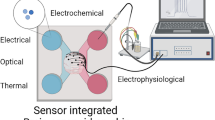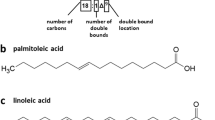Abstract
The fatty acid (FA) composition and distribution in a variety of phospholipids (PL) and neutral lipids (NL) at two discrete stages during the embryonic rat brain development were investigated. Over 96% of the FA were acylated into fetal brain PL at embryonic day 17 after the peak of neuronal proliferation and at embryonic day 20, one day prior to delivery. Phosphatidylcholine constituted approximately 60% of the total PL pool, phosphatidylethanolamine (PE) 30%, phosphatidylserine (PS) 6%, and phosphatidylinositol (PI) 4%. The diacylglycerols and triacylglycerols constituted 1–2% of the fetal brain lipids. α-Linolenic acid (18∶3n−3) and linoleic acid (18∶2n−6) were found in very low amounts in all fetal brain PL and NL. The percentage of the n−6 polyunsaturated FA, consisting of arachidonic acid (AA), 22∶4n−6 and 22∶5n−6, remained unchanged in all the fractions, except in Pl, in which the proportion of AA increased. The concentration of docosahexaenoic acid (DHA) increased with age in all the fractions, with the bulk of accumulation accounted for by its increase in PE and, to a lesser extent, in PS. This finding suggests a “DHA accretion spurt” during the last three days of pregnancy.
Similar content being viewed by others
Abbreviations
- AA:
-
arachidonic acid
- DG:
-
diacylglycerol
- DHA:
-
docosahexaenoic acid
- E17, E20:
-
embryonic day 17, 20
- FA:
-
fatty acid
- LA:
-
linoleic acid
- LNA:
-
α-linolenic acid
- NL:
-
neutral lipids
- PC:
-
phosphatidylcholine
- PE:
-
phosphatidylethanolamine
- P8:
-
postnatal day 8
- PI:
-
phosphatidylinositol
- PL:
-
phospholipid
- PS:
-
phosphatidylserine
- PUFA:
-
polyunsaturated FA
- TG:
-
triacylglycerol
References
O'Brien, J.S., and Sampson, E.L. (1965) Fatty Acid and Aldehyde Composition of the Major Brain Lipids in Normal Gray Matter, White Matter and Myelin,J. Lipid Res. 6, 545–551.
Sun, G.Y., and Horrocks, L.A. (1968) The Fatty Acid and Aldehyde Composition of the Major Phospholipids of Mouse Brain,Lipids 3, 79–83.
Dhopeshwarkar, G.A., and Subramanian, C. (1976) Intracranial Conversion of Linoleic to Arachidonic Acid: Evidence for Lack of Δ8-Desaturase in the Brain,J. Neurochem. 26, 1175–1179.
Dhopeshwarkar, G.A., and Subramanian, C. (1976) Biosynthesis of Polyunsaturated Fatty Acids in the Developing Brain: II. Metabolic Transformations of Intracranially Administered [3-14C]Eicosatrienoic Acid, Evidence for Lack of Δ8-Desaturase,Lipids 11, 689–692.
Green, P., and Yavin, E. (1993) Elongation, Desaturation and Esterification of Essential Fatty Acids by Fetal Rat Brainin Vivo, J. Lipid Res. 34, 2099–2107.
Sinclair, A.J., and Crawford, M.A. (1972) The Accumulation of Arachidonate and Docosahexaenoate in the Developing Brain,J. Neurochem. 19, 1753–1758.
Cunnane, S.C., and Chen, Z.-Y. (1992) Triacylglycerol: an Important Pool of Essential Fatty Acids During Early Postnatal Development in Rats,Am. J. Physiol. 262, R8-R13.
Cunnane, S.C., and Chen, Z.-Y. (1992) Quantitative Changes in Long-Chain Fatty Acids During Fetal and Early Postnatal Development in Rats,Am. J. Physiol. 262, R14-R19.
Burdge, G.C., and Postle, A.D. (1994) Hepatic Phospholipid Molecular Species in the Guinea Pig: Adaptations to Pregnancy,Lipids 29, 259–264.
Burdge, G.C., and Postle, A.D. (1995) Phospholipid Molecular Species Composition of Developing Fetal Guinea Pig Brain,Lipids 30, 719–724.
Berridge, M.J. (1984) Inositol Triphosphate and Diacylglycerol as Second Messengers,Biochem. J. 220, 345–360.
Epand, R.M., and Lester, D.S. (1990) The Role of Membrane Biophysical Properties in the Regulation of Protein Kinase C Activity,Trends Pharmacol. Sci. 11, 317–320.
Nishizuka, Y. (1986) Studies and Perspectives of Protein Kinase C,Science 233, 305–312.
Hara, A., and Radin, N.S. (1978) Lipid Extraction of Tissue with a Low-Toxicity Solvent,Anal. Biochem. 90, 420–426.
Kunievsky, B., Bazan, N.G., and Yavin, E. (1992) Generation of Arachidonic Acid and Diacylglycerol Second Messengers from Polyphosphoinositides in Ischemic Fetal Brain,J. Neurochem. 59, 1812–1819.
Yavin, E., and Zutra, A. (1977) Separation and Analysis of [32P]-Labeled Phospholipids by a Simple and Rapid Two-Directional Thin-Layer Chromatography Procedure and Its Application to Cultured Neuroblastoma Cells,Anal. Biochem. 54, 1809–1811.
Green, P., and Yavin, E. (1996) Natural and Accelerated Docosahexaenoic Acid Accumulation in the Prenatal Rat Brain,Lipids 31, S-235–S-238.
Bartlett, G.R. (1959) Phosphorus Assay in Column Chromatography,J. Biol. Chem. 234, 466–468.
Breckenridge, W.C., Gombos, G., and Morgan, I.G. (1972) The Lipid Composition of Adult Rat Brain Synaptosomal Plasma Membranes,Biochim. Biophys. Acta 266, 695–707.
Breckenridge, W.C., Morgan, I.G., Zanetta, J.P., and Vincendon, G. (1973) Adult Rat Brain Synaptic Vesicles: II. Lipid Composition,Biochim. Biophys. Acta 320, 681–686.
Sun, G.Y., and Sun, A.Y. (1974) Synaptosomal Plasma Membranes: Acyl Group Composition of Phosphoglycerides and (Na++K+)-ATPase Activity During Fatty Acid Deficiency,J. Neurochem. 22, 15–18.
Baker, R.R., and Thompson, W. (1972) Positional Distribution and Turnover of Fatty Acids in Phosphatidic Acid, Phosphoinositides, Phosphatidylcholine and Phosphatidylethanolamine in Rat Brainin vivo, Biochim. Biophys. Acta 270, 489–503.
Marshall, E., Fumagalli, R., Niemiro, R., and Paoletti, R. (1966) The Change in Fatty Acid Composition of Rat Brain Phospholipids during Development,J. Neurochem. 13, 857–862.
Bolen, E.J., and Sando, J.J. (1992) Effect of Phospholipid Unsaturation on Protein Kinase C Activation,Biochemistry 31, 5945–5951.
Dobbing, G. (1972) Vulnerable Periods of Brain Development, inLipids, Malnutrition and the Developing Brain (Elliot, K. and Knight, J., eds.) pp. 9–20, Associated Scientific Publishers, Amsterdam.
Innis, S.M. (1991) Essential Fatty Acids in Growth and Development,Prog. Lipid Res. 30, 39–103.
Martinez, M. (1989) Dietary Polyunsaturated Fatty Acids in Relation to Neural Development in Humans, inDietary ω3 and ω6 Fatty Acids. Biological Effects and Nutritional Essentiality (Galli, C., and Simopoulos, A.P., eds.) pp. 123–133, Plenum Press, New York, London.
Cook, H.W. (1981) Metabolism of Triacylglycerol in Developing Brain,Neurochem. Res. 6, 1217–1229.
Pawlosky, R.J., Ward, G., and Salem Jr., N. (1996) Essential Fatty Acid Uptake and Metabolism in the Developing Rodent Brain,Lipids 31, S-103–S-107.
Scott, B.L., and Bazan, N.G. (1989) Membrane Docosahexaenoate Is Supplied to the Developing Brain and Retina by the Liver,Proc. Natl. Acad. Sci. USA 86, 2903–2907.
Pawlosky, R.J., Barnes, A., and Salem Jr., N. (1994) Essential Fatty Acid Metabolism in the Feline: Relationship Between Liver and Brain Production of Long-Chain Polyunsaturated Fatty Acids,J. Lipid Res. 35, 2032–2040.
Sinclair, A.J., and Crawford, M.A. (1972) The Incorporation of Linolenic and Docosahexaenoic Acid into Liver and Brain Lipids of Developing Rats,FEBS Lett. 26, 127–129.
Nakashima, Y., Yuasa, S., Hukamizu, Y., Okuyama, H., Ohara, T., Kameyama, T., and Nabeshima, T. (1993) Effect of a High Linoleate and a High α-Linolenate Diet on General Behavior and Drug Sensitivity in Mice,J. Lipid Res. 34, 239–247.
Stubbs, C.D., and Smith, A.D. (1984) The Modification of Mammalian Membrane Polyunsaturated Fatty Acid Composition in Relation to Membrane Fluidity and Function,Biochim. Biophys. Acta 779, 89–137.
Galli, C., Trzeciak, H.I., and Paoletti, R. (1971) Effects of Dietary Fatty Acids on the Fatty Acid Composition of Brain Ethanolamine Phosphoglyceride: Reciprocal Replacement of n−6 and n−3 Polyunsaturated Fatty Acids,Biochim. Biophys. Acta 248, 449–454.
William, W.H. (1991) The Role of Placental-Fetal Interaction in Fetal Nutrition,Sem. Perinatol. 15, 424–433.
Author information
Authors and Affiliations
About this article
Cite this article
Green, P., Yavin, E. Fatty acid composition of late embryonic and early postnatal rat brain. Lipids 31, 859–865 (1996). https://doi.org/10.1007/BF02522981
Received:
Revised:
Accepted:
Issue Date:
DOI: https://doi.org/10.1007/BF02522981




